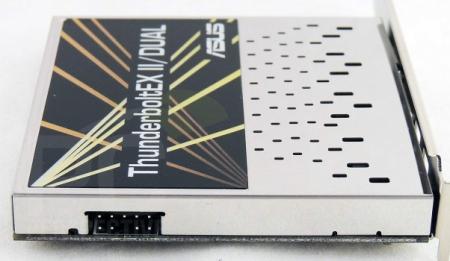-
Posts
90 -
Joined
-
Last visited
-
Days Won
2
Content Type
Profiles
Forums
Downloads
Everything posted by juniordiscart
-
Hi Jamie I know you will probably wait for someone to confirm this, but just to give an idea to have a more neat solution than to bend a wire and stick it in the ATX power cable, you can buy these kind of switches. This guy uses it as well. You can see it clearly in the second and third picture. Yeah, but every PSU manufacturer assumes their PSU will be used inside a regular PC, connecting the necessary cables to the proper devices.
-
Hey Jamie The RM450 PSU will start spinning its fan when the load is above a certain percentage (something between 50% or 70% I believe). When using a PSU, and just connecting the necessary connections (the PCIe 6pin and 8pin plugs to your graphics card) will not start the PSU when turning on the Sonnet SEL. The PSU needs to be started "manually", that means, the ATX power connector (the big fat cable) needs to be given the signal to turn on, like when pressing a power button on a computer. You can achieve this with these kind of mechanisms. This is what makes solutions like the SEL and SE II to be unelegant implementations. Products like the EXP GDC and BPlus PE4C v2.0 take care of this issue by allowing the ATX power connector to be connected to the board and putting in a time delay switch. I hope this helps.
-

EXP GDC Beast/Ares-V7/V6 discussion
juniordiscart replied to jacobsson's topic in Enclosures and Adapters
Oeh, nice. I'm not doing an eGPU project at the moment, but I'm examining all possible options, and was also looking at the Silverstone SFX 450 Watt Gold edition. I wonder why Cloud did it that way... Very confusing setting it up like that. I'm looking forward to your pictures. -
It seems I can't get any response from ASUS about the TB_HEADER cable. I dug some more and I came by this webshop: MaxExpansion. They sell PCIe backplanes with ATX powersupply connectivity. It are the same circuit boards used in their CUBE enclosure series which can be configured with a Thunderbolt option. I think they may be a better option than purchasing an EXP GDC or BPlus PE4C V2.0 along with a PCIe riser as suggested in my quote by Nando in the first post. Maybe their PCIe backplane that is in closeout sale could be quick test bed for someone willing to cheaply try out the ASUS ThunderboltExII. They also used to sell their Thunderbolt PCIe add-in card separately, but they and their resellers took them all down. :/ This would have been ideal for a Thunderbolt-only setup.
-
I have sent an e-mail to ASUS support, still waiting for a reply though. I also found that the HP Thunderbolt expansion cards (they are not listed on the certified Thunderbolt Products list by Intel, but can be bought on Amazon) also have a similar header. The HP website also mentions they are only usable on certain motherboards. So it could indeed be a whitelisting mechanism, or as prizm3d linked, that it is used for timing and low-level system calls.
-

EXP GDC Beast/Ares-V7/V6 discussion
juniordiscart replied to jacobsson's topic in Enclosures and Adapters
The PE4C v2.0 is supposed to launch mid-june this year, so we might see it soon, but for now, I doubt you will find any one who has it and can tell how good or bad it works. -
It has been taken out of production because Intel or Apple didn't want it certified or something. You can't buy it any longer, which is real bummer for many of us.
-
That's very interesting indeed. I'd like to see that as well. HDMI 1.3 seems to have a throughput of 10.3Gb/s (and it goes up from there, 20Gb/s for HDMI 2.0), which is a tad more than the first generation of Thunderbolt. I guess, when somebody should buy the PE4C V2.0, it would be cheap and easy to test out. One thing I'm not sure about is that there is no "Thunderbolt to HDMI" converter, all I can find is "Displayport to HDMI". So the question is also: will Displayport recognize that at the other end of the cable, a PCIe device is running?
-
Relentless, do happen to have some more picture of the circuitboards? I'm wondering whether the board could be hooked up to another PSU. Thanks.
- 26 replies
-
- apple egpu
- diy egpu
- (and 7 more)
-

eGPU experiences [version 2.0]
juniordiscart replied to Tech Inferno Fan's topic in DIY e-GPU Projects
Very intersting find Nando, thanks! When I read the name on Amazon.com I believe they are split, not routed (if I interpret it correctly). What would be the consequence if they appear to be routed instead of split? Edit: Looking at the specifications of the Asus PCIe card (and HP also has one), they each require a header to be connected to the motherboard, only available on certain motherboards... So I guess this would be a dead-end as well. -

eGPU experiences [version 2.0]
juniordiscart replied to Tech Inferno Fan's topic in DIY e-GPU Projects
Hey guys I recently got very interested in eGPU projects, and maybe would start one in the near future, and preferably a Thunderbolt one. Now, it seems like Intel is refusing to certify products like the Silverstone T004 and BPlus TH05 which would make all of our lives a little bit easier. I was wondering however, whether the following suggestion would be feasible to implement by BPlus (as I understand correctly, they cooperate with this community to make eGPU happen) and as a Thunderbolt eGPU solution as a whole: Let BPlus design a circuitboard like they do now with, but instead of one PCIe slot, a second PCIe slot that could be used to plug in something like this: Thunderbolt PCIe card This way, they don't have to certify anything by Intel, and we get to buy a "cheap" add-in card. Would this kind of thing work? When plugging a Thunderbolt laptop into the port, would it recognize that there is GPU running next to it? Just an idea I'm throwing around, and sorry if this came by before. I'd like to test this myself, but I have neither the equipment, the time or money to invest in this right now. Cheers! -
I think he completely dis-assembled the Sonnet, and removed the Thunderbolt card as well, which is also plugged in as a PCI-e card. So there are 3 PCI-e slots, but only two are available for your own devices.
- 26 replies
-
- apple egpu
- diy egpu
- (and 7 more)




